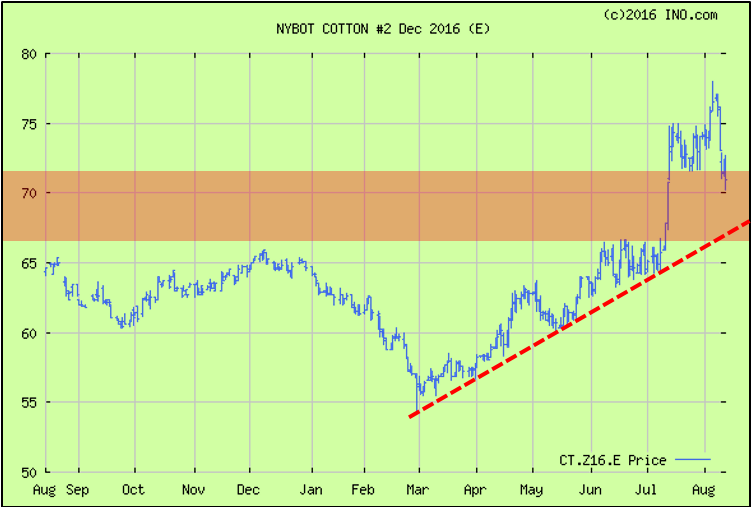In a recent newsletter, I referred to the sudden increase in cotton prices as “Christmas in July.” Well, as we all know, the new wears off eventually—even for Christmas gifts. July was a good month, but so far August has not been. Prices have come under pressure over the past week or so, and have declined 5 to 6 cents per lb. Prices (Dec16 futures) currently stand in the 71-cent area—the lowest level in a month. Prices broke sharply on Tuesday last week and continued to decline the rest of the week. Is there reason to panic? Well, if you took advantage of the recent rally, and got a good portion of expected 2016 production priced or protected in some way, the answer is “No.” If you didn’t, the answer is a strong “Maybe.”
I think a lot of growers are at least one-third priced/protected and some as much as half or even more. It’s always a tough decision on how far to crawl out on the limb with bale contracts, but given last year’s prices in the 60’s, and stuck in the 60’s again this season until a month ago, there was little reason to turn down a sudden and unexpected opportunity in the 70’s. I know some folks had 78 or 80 cents on their minds and we never quite got there. Hopefully, some of expected production got locked in before this week’s decline.
The market has gotten mixed signals over the past couple of weeks. So, the decline in prices has not been easy to digest and understand. It’s also more difficult to figure out where this market might go from here.
Crop Conditions and US Crop Estimate. First of all, crop conditions have declined. The crop is not rated as well as last year’s crop, which was not a stellar crop yield wise (766 lbs/acre). But west Texas got rain this week, so that may have been one reason for the decline in prices. We’ve also had rains here in Georgia and the crop is looking better than it was a month ago.
The US crop is now estimated at 15.88 million bales—up 80,000 bales from the July estimate on a yield of 800 lbs per acre. This is 34 lbs per acre more than last year (did I mention the crop is actually rated worse than last year) and 15 lbs less than the July estimate. The larger crop comes from an increase in acres expected to be harvested (less abandonment).
China Reserve. Also this week, official word came that China will extend their government reserve sales by a month, until the end of September. This could be good or bad. The good would be that it could lead to both higher mill use and further reduce China’s stocks. The bad is that this apparently has raised concern that China may likely import even less cotton than the already very low level it was expected to import.
World Production and Use. Today’s USDA August supply and demand numbers dropped expected World cotton demand by 340,000 bales. This is 0.3% and may not be much in the grand scheme of things, but it sends a nervous signal to the market. Projected Cotton Use has been trending up, and it’s one of the reasons prices have improved like they have. Half of the decline comes in Vietnam—where they have been importing cotton and manufacturing yarn and shipping it to places like China. Now China is selling off its government reserves and increasing their own spinning and yarn production.
World cotton production was reduced 1 million bales from the July estimate. This is largely accounted for by the India crop being cut ½ million bales, and the China crop also cut ½ million bales. A smaller India crop is a bit of a surprise because their monsoon season has been above average.

Outlook. The area between roughly 67 and 71 cents is largely untested. Prices blew through that area in 2 days. Prices may have gone too high too quickly—but we’ve seen this before. Prices may try to rebound to get above that 71 cent mark, but don’t be surprised if prices test this area below 71 cents.
Prices should have support at 67 to 68 cents, however. This is a time of year where prices typically trend down until harvest time—but that depends on having no unexpected reductions in crop size and having a “normal” harvest. So, the market will keep an eye on the US and foreign crops.
Source:ufl.edu